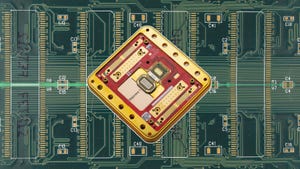Cisco: Unified Computing is an 'Inflection Point'Cisco: Unified Computing is an 'Inflection Point'
Cisco's Unified Computing strategy goes beyond a single server, than larger the latest step in a larger battle for the data center, with Cisco seeking to position its technology at the heart of a virtualized infrastructure doing business on the Inter-Cloud of the future
March 16, 2009
Yes, there's a new Cisco blade server. But Cisco's announcement today of its Unified Computing strategy goes beyond a single server. It's the latest step in a larger battle for the data center, with Cisco seeking to position its technology at the heart of a virtualized infrastructure doing business on the Inter-Cloud of the future.
"Today is a very important day for us," said Cisco CEO John Chambers. "We're really talking about the data center ... and how this will change business forever."
The Unified Computing System brings together hardware - including the new B-Series blade server and network adapters - that seamlessly connect with storage systems over a high-speed unified network fabric powered by Cisco's new Nexus family of switches, enabling virtualized assets to move seamlessly across the data center and the Internet. Cisco is also introducing new UCS Manager software to manage and provision resources within the Unified Computing System.
Cisco's introduction of a blade server has raised expectations of tensions with long-time partners IBM and HP. In launching the server and other new products forming its Unified Computing System, Cisco surrounded itself with high-profile partners (including Microsoft, Intel, VMware, EMC, Red Hat and BMC) and emphasized the breadth of its strategy, rather than competition with server vendors.
"You can't think of this as a blade or a network," said Cisco senior VP Rob Lloyd. "You need to think of it as a system. That's why we don't think we're competing as a blade platform, but as a system."
"Cisco is creating a sub-category of the server market - a specialized market we call Unified Computing," said Doug Gourlay, Vice President of Data Center Solutions for Cisco. "This is not the ‘Clash of the Titans’ or us ‘coming after HP or IBM or Dell’. Some companies may choose to join us in this market, others may continue to operate the status quo. We are certain over time we will not be alone in this market."
Cisco's strategy is driven by virtualization. Chambers emphasized that Cisco sees an "inflection point" for virtualization that will transform the data center and requires a new architecture to allow companies to take full advantage of the mobility of virtual machines.
"The Virtual Machine has become the new atomic building block of the data center, creating new challenges and opportunities with the potential to transform the computing environment and deliver significant benefits," said Mario Mazzola, senior vice president, Server Access and Virtualization Business Unit, Cisco. "Taking advantage of this architectural shift in the data center, we developed a unique new computing model that transforms the data center into a dynamic IT environment with the power to increase productivity, improve business agility and drive the benefits of virtualization to an entirely new level."
VMware CEO Paul Maritz said the shift in the data center is clear. "There's no debate about whether virtualization is a good strategy; every company is thinking about it," said Maritz, who called Cisco's Unifed Computing "one of the compelling events that will get people off the dime and accelerate the move to a virtualized environment."
Key to the system is the Cisco UCS Manager (PDF), which provides management capabilities through a graphical user interface, command line interface and an application programming interface (API). "Service profiles help to automate provisioning and increase business agility, allowing data center managers to provision applications in minutes instead of days," Cisco says in its description.
About the Author
You May Also Like







